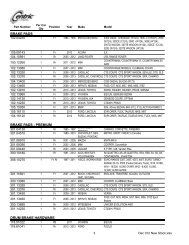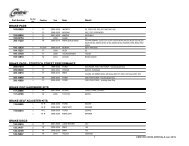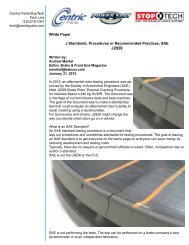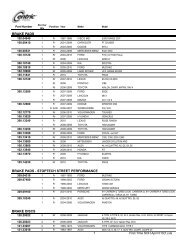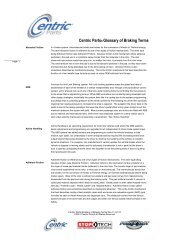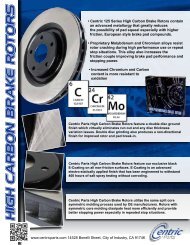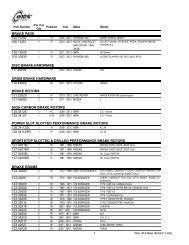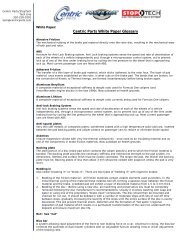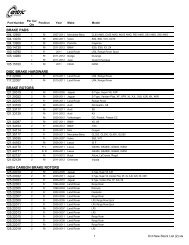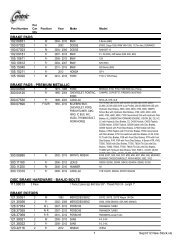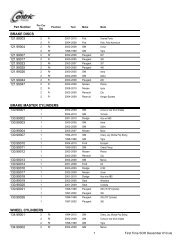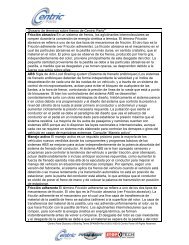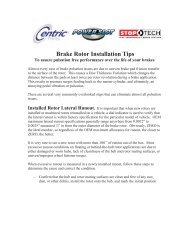Brake Fluid Basics â Ratings Explained - Centric Parts
Brake Fluid Basics â Ratings Explained - Centric Parts
Brake Fluid Basics â Ratings Explained - Centric Parts
Create successful ePaper yourself
Turn your PDF publications into a flip-book with our unique Google optimized e-Paper software.
<strong>Centric</strong> <strong>Parts</strong>/StopTech<br />
Tech Line<br />
310-218-1091<br />
tech@centricparts.com<br />
White Paper:<br />
<strong>Brake</strong> <strong>Fluid</strong> <strong>Basics</strong> – <strong>Ratings</strong> <strong>Explained</strong><br />
<strong>Brake</strong> fluid is possibly the single most neglected component of the automobile. Most high performance drivers<br />
check their tire pressures and change their engine oil at frequent intervals, but virtually no one ever changes<br />
the brake fluid in their street car. The function of brake fluid is to provide an incompressible medium to<br />
transmit the driver’s foot pressure on the brake pedal through the master cylinder(s) to the calipers in order to<br />
clamp the friction material against the discs. The foot pressure is multiplied by the mechanical pedal ratio and<br />
the hydraulic ratio of the master cylinders, booster (if used) and caliper piston(s).<br />
This is a simple concept. When fresh, all brake fluids are virtually incompressible and the system works as well<br />
as its mechanical and hydraulic design allows. There can be, however, significant problems in the proper<br />
functioning of brake fluid. Overheated brake fluid can (and will) boil in the caliper. Boiling produces gas<br />
bubbles within any boiling fluid. Gas is compressible so boiling brake fluid leads to a “soft” brake pedal with<br />
long travel. In extreme cases overheated brake fluid necessitates “pumping the brake pedal” in order to get a<br />
pedal at all.<br />
This leads to a discussion of boiling points. <strong>Brake</strong> fluids are classified by both “dry boiling point” and “wet<br />
boiling point.” They are also classified by US Department of Transportation (DOT) rating, DOT 3, DOT 4, DOT<br />
5, and DOT 5.1.<br />
The U.S. Government specifications for brake fluid, FMVSS 116, do not dictate the chemical composition of a<br />
given classification, or “grade” of brake fluid. Instead FMVSS116 defines the properties of the fluid, such as dry<br />
and wet boiling points (referred to as the equilibrium reflux boiling points, dry and wet), viscosity of the brake<br />
fluid grade at certain temperatures, high temperature stability, corrosion characteristics, and the effects of the<br />
fluid on seals, as well as other physical properties like the tendency to jell or separate (called stratification) or<br />
form sludge and/or crystalline deposits. Boiling point and viscosity are the most relevant properties to most<br />
consumers, including high performance customers. Viscosity is an important factor for proper operation of ABS<br />
and Active Handling Control systems on modern vehicles since in most cases the pressure and volume of fluid<br />
transferred is not measured. Instead, flow through a valve with a given orifice size over time are the control<br />
mechanism, so fluid maximum viscosity is a key characteristic.<br />
This discussion does not require a thorough review of the Federal Standard, which also includes testing<br />
procedures and storage and labeling of containers, but one aspect of the regulation that deserves attention<br />
here is the importance of the container used to ship the brake fluid. Non-silicone-based brake fluid is strongly<br />
hygroscopic, meaning that it naturally absorbs water from the humidity in the air. That is why the shipping<br />
container and the brake reservoir have to function as a barrier to the moisture in the air reaching the brake<br />
fluid. Modern brake reservoirs are thick enough, and the bellow seals on top function well enough, to provide a<br />
long life to the fluid once in use. The container the fluid is delivered in is just as important. The best type of<br />
container is a metal one, as it performs the function of a moisture barrier much better than thin plastic bottles<br />
- even when those plastic bottles are made from engineered materials. The technology does not exist today to<br />
make the plastic container perform as well as metal at a reasonable cost.<br />
DOT 3 fluids are usually glycol ether based, but as stated earlier, that is not because they are required to be.<br />
The brake fluid industry has determined by consensus that glycol ether fluids are the most economical way to<br />
meet the requirements.<br />
By definition, DOT 3 fluids must have a minimum dry boiling point (measured with 0 percent water by volume)<br />
of 401°F and a minimum wet boiling point (measured with 3.7 percent water by volume) of 284°F. The<br />
specification says little more as far as the performance enthusiast is concerned.<br />
DOT 4 fluids are also glycol ether based, but have a measure of borate esters added for improved properties<br />
including increased dry and wet boiling points. A seldom talked about characteristic is that because of this<br />
chemistry, the DOT 4 fluid will have a more stable and higher boiling point during the early portion of its life,<br />
but ironically once the fluid does actually begin to absorb water its boiling point will typically fall off more<br />
rapidly than a typical DOT 3. By FMVSS116 standards, DOT 4 fluids must have a minimum dry boiling point of<br />
446°F and a minimum wet boiling point of 311°F.<br />
DOT 4 is the grade applicable to most race engineered brake fluid in the world today, especially with regard to<br />
viscosity limit. Note that although the DOT 4 designation has a minimum dry and wet boiling point, a DOT 4<br />
racing brake fluid may have a dry boiling point over 600F. Its viscosity is challenged, however, to be under the<br />
viscosity limit of 1,800 mm2/sec. Some claimed racing brake fluids exceed this important limit. Caution should<br />
be exercised if these fluids are used in race cars with ABS systems. This does not mean that DOT 4 fluids are<br />
necessarily better than DOT 3 fluids. Remember, the boiling points listed are minimums. There are certain DOT<br />
3 fluids with higher boiling points than some DOT 4 fluids. The real differentiating factor is that DOT 4 fluid<br />
should be changed more often than a DOT 3 fluid, because of the effects and rates of water absorption.
<strong>Centric</strong> <strong>Parts</strong>/StopTech<br />
Tech Line<br />
310-218-1091<br />
tech@centricparts.com<br />
The original DOT 5 fluid specification was expected to be fulfilled by silicone based (SSBF) composition. It<br />
was designed for use in applications where its resistance to water absorption (and therefore low corrosion) was<br />
desired - like in military equipment. It has also found use in antique cars because it does not dissolve paint<br />
finishes. With SSBF, unfortunately, these characteristics were only achieved by unacceptably high<br />
compressibility. As such, the DOT 5 grade SSBF is of little value to any conventional automotive or high<br />
performance application.<br />
Subsequently there have been non-silicone based fluids developed that meet DOT 5 wet and dry boiling point<br />
specifications and viscosity requirements. They are referred to as DOT 5.1 grade fluids. As a special case they<br />
are listed here for completeness.<br />
Please remember that the specifications are minimums and therefore the non-SSBF DOT 5 fluids do not offer<br />
the highest boiling points available. There are no DOT 5.1 brake fluids that exceed the dry and wet boiling<br />
points of the best of currently available DOT 4 racing brake formulas. They do meet the lower viscosity<br />
specifications, however.<br />
<strong>Fluid</strong> Grade<br />
Dry ERBP (°F) Wet ERBP (°F) Viscosity Limit Chemical<br />
@0.0% H2O<br />
@3.7% H2O (Cp @-40°F) Composition<br />
DOT 3 401 284 1500 mm2/s Glycol Ether Based<br />
DOT 4 446 311 1800 mm2/s<br />
Glycol Ether /<br />
Borate Ester<br />
DOT 5 (SSBF) 500 356 900 mm2/s Silicone Based<br />
DOT 5.1 500 356 900 mm2/s<br />
Borate Ester /<br />
Glycol Ether<br />
One last note on the DOT ratings: Systems designed for a particular type of fluid (especially prior to the wide<br />
distribution and use of DOT 4 fluids) should continue to be filled with that fluid. For example, in a car that was<br />
delivered with DOT 3 fluid, the internal components of the system (seals, brake hoses, and fittings for<br />
example) were specifically designed and tested for compatibility with the chemical composition of DOT 3 fluid.<br />
Because the DOT 4 grade fluid typically contains a different chemical composition, compatibility of system<br />
components may be an issue.<br />
By Steve Ruiz, Engineering Manager at <strong>Centric</strong> <strong>Parts</strong>/StopTech<br />
About <strong>Centric</strong> <strong>Parts</strong> ®<br />
<strong>Centric</strong> <strong>Parts</strong>®, which includes the StopTech® and Power Slot® divisions, is a leading manufacturer and<br />
supplier of aftermarket brake components and systems for everyday cars, performance duty vehicles and ultra<br />
performance vehicles. The Southern California company was founded in 2000 and now employs over 500<br />
workers at its multiple warehouse and production facilities that total more than half a million square feet of<br />
floor space. The company’s skilled and seasoned engineers and experts, and an award-winning executive team<br />
drawn from across the industry, fuel <strong>Centric</strong> <strong>Parts</strong>’ mastery of the automotive aftermarket and its dedication to<br />
research and development. The patent-holding company also has one of the industry’s best programs for<br />
tracking and cataloging original equipment parts and uses this expertise to devise and deliver quality<br />
aftermarket and OE parts for consumers, technicians and auto makers.<br />
About StopTech®<br />
StopTech®, the ultra performance and racing division of <strong>Centric</strong> <strong>Parts</strong>®, is a leading innovator of world class<br />
brake components and systems for production-based racing cars and high performance vehicles on the street<br />
and track. Founded in 1999, StopTech was the first to offer Balanced <strong>Brake</strong> Upgrades® for production cars and<br />
remains the worldwide leader with over 650 platform offerings to dramatically improve overall braking<br />
performance. StopTech’s industry leading technologies and materials, from rock solid calipers to ingeniously<br />
efficient heat handling rotors, result in shorter stopping distances, better brake modulation and less brake<br />
fade.<br />
# # # #



